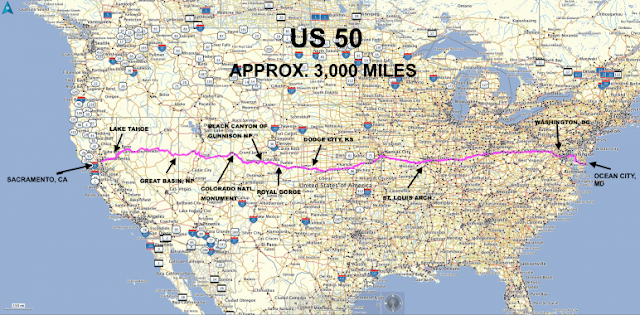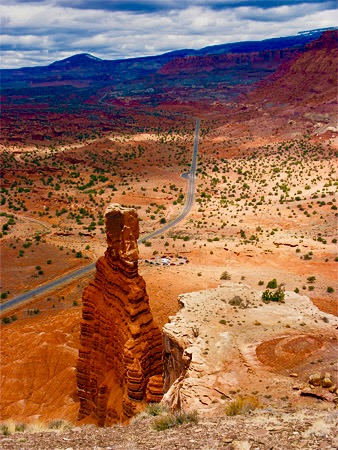After my
desert "adventure," it was unclear where I'd wander next. As most
people I talked with were headed to Bryce Canyon and Zion, it seemed wise to go
the other direction, which took me along the mostly two-lane stretch of asphalt
considered the backbone of America. That's right, the famous Highway 50, dubbed
in 1986 by Life Magazine as "The
Loneliest Road in America."
Better
men and women than I had braved this trail across Nevada and lived to tell the
tale. Jack Kerouac wrote about it in the beat-era epic On the Road. William Least-Heat Moon waxed most eloquently about
his classic, Blue Highways. If these
dudes could do it, and survive, I surmised, I damn well could too.
Following
the trail of the Pony Express beginning in 1860 and the Lincoln Highway dating
to 1913, the 3,007-mile Highway 50 winds its way from Ocean City, Maryland to
Sacramento, California through alpine forests and desert valleys, passing ghost
towns, dinosaur remains and national parks and through numerous small towns
that are barely blips on the map.
My
entrance onto 50 was to begin from Highway 21, which proved to be the most
desolate part of the journey. It was bleak and absolutely carless except for the
Zen Gypsy Van. Steep grades and hairpin turns through five mountain passes were
to await me as I traveled from Ely to Austin, with long stretches of open
landscape laced with gold grasses and wildflowers sandwiched between. The
greatest danger proved to be deer. I kept a vigilant watch and had to slow for
several herds along the way.
It was
indeed a strange experience to see only a few cars along a 400-mile stretch.
But it never felt lonely. It was more like a long, very peaceful, very rhythmic
and convoluted conversation with your inner self. As Alexander Nazaryan noted in his
Newsweek article, Route 50: Driving America's 'Loneliest Road,' " I suppose, then, that Route 50 can be considered a meditation retreat
with a speed limit—mindfulness at 100 miles an hour." True. You became transfixed by the sound of your
tires, mesmerized by the gold-grey clouds overhead, the seeming endlessness of
the desert, and then yet another mystical mountain appearing like some kind of
satori ahead. As Nazaryan also comments: "Whatever way the
compass points, the true direction of the journey is always inward, ever deeper
into the infinite soul of the land." Yes,
indeed. Yes.
It was a
soul road, for sure.
After 7
hours when my eyes began to blur, around Austin, I pulled over at The Cozy Mountain Inn,
which proved to be just that . . . a simple, comfortable and heavenly respite
for a weary traveler. The owner, Cindy
Walsh, was as welcoming as could be and we had fun talking about solo camping.
She had just purchased a vintage teardrop camper and was getting ready to
restore it and think about getting on the road herself.
I gassed
up, and another 7 and a half hour drive through the rest of Nevada was
alternately shockingly beautiful and bland. As the miles flew by, again through
mountain ranges and valleys, I knew I was truly in the West, as now in addition
to signs for deer and cow crossings, there were horse warnings (with flashing
signs, no less!), though I never encountered a mustang. The small towns in
between were forgettable strips of casinos, pawn shops, whore houses and beer
joints. Now, I've been in my share of beer joints in my life, some of which are
pretty fascinating crucibles for a writer, but none of the above were seductive
enough to lure me in, even out of curiosity.
I sped
past the salt flats, like a grey ocean stretching to the horizon on either side
of the highway, where I could see the indentations of tire tracks of those who
sought to test out speeds of up to 120 mph, and then into was on to the last
stretch of Nevada and into well-populated Carson City. From there it was back
up into the mountains where now very tall pine trees made my eyes water. Just
to see this expanse of green again and to know I would soon be in California
was like a balm for my tired eyes.
Coming
into Tahoe City, however, after two days of almost total silence, was a shock.
It was Labor Day Weekend and there were literally thousands of tourists milling
about the cafes, bars, boutiques and the high-end casinos as well as throngs
returning from 'Burning Man.' As I peered down this section of Highway 50, I
saw an endless stream of cars, bumper-to-bumper, making a beeline into Lake
Tahoe from Sacramento and San Francisco.
Far from
the loneliest road now! I turned down Route 89 and headed through what looked
like national forest. Ahhh. Quieter and quieter—until I came to a line of cars
backed up for several miles. Uh oh. They were all turning into the destination
dialed into my GPS, Camp Richardson, where I'd heard there were over 220
campsites. I entered the hotel there and inquired at the desk. Every single
campsite and cottage was taken. Wow. Now what?
As I
stood there, the clerk fielded a phone call. "There's no campsites,"
he said. "But we now have one room here at the hotel." I handed him
my credit card. "You're one lucky duck," he told me. "Everything
in town is booked."
I felt
like flapping my wings and quacking. "Believe you me, mister, that's a
proven fact!" I said. I tossed my pack in my room and made the 5-minute
walk down to the beach restaurant to see if I could find myself a much-needed
glass of wine. This turned out to be like divining for water in the backside of
the Utah desert. The bar was packed ten-deep with drunken twenty-somethings and
the roar of these crazed, half-naked revelers (well, there was an upside) was
just too much for me to bear.
There was
a funny moment when two guys carrying Piña Coladas walked out onto the deck.
"Where'dj they go?" one muttered in slurred surprise, apparently
referring to the girls they'd bought the drinks for, now long gone. "Bloody
Bitches!" the other shouted, downing his Piña Colada in one swallow, and
tossing the plastic cup in the trash. His friend shrugged, followed suit, then
they turned, like twin inebriated ships, back towards the bar.
Welcome
to what my daughter used to call, "sizzle-ization."
I skirted
the bar buzz and strolled down the pier to the end where a "Rum
Runner" cruise was about to depart. I talked to the owners for a bit then
headed back to my sweet and simple room. There was no tv, just basically a bed
and a bathroom. Still thirsty, I improvised and made a cocktail from some
crushed ice, the final drop of vodka in my cooler and the last already somewhat
mashed-up Palisade peach. It was pretty darn good if I do say so myself! I made
a supper of some good goat cheese, crackers and salami and sank into a
well-deserved slumber.
I was now
in striking distance of home, but I had one more important item on my Zen Gypsy
list—to see my good friends Susanna and Jimmy Cubbage, who now lived in Tahoe. That
morning I toured the lake itself on the way to their place in Incline Village,
which gave me new insight into how absolutely stunning this area is. Along the
way I stopped at Rosie's Diner for some good coffee and a bit of breakfast. The
place was packed, but I managed to squeeze in at the bar and had a nice time
chatting with the bartender, who at one point, downed a shot of Jack Daniels.
"Breakfast," he said, smiling and wiping his moustache. I toasted him
with my coffee. I believe I was the only one in the place who wasn't drinking a
Mimosa or a Bloody Mary or some other brunch concoction. Tempting, but I still
had some mountain driving to do.
My time
with my dear friends and their dog, Zoey, was like gold. They took me on a
lovely hike through one of the most beautiful meadows I've ever seen and served
me a fabulous dinner of roasted salmon, good hearty salad and my friend Susanna's
famous homemade rye bread. Having a home-cooked meal with people you love was
one of the best things that happened to me along the way. It was a tearful farewell
(never goodbye!) the next morning, but I felt so blessed to have gotten to
spend some quality time with them.
And, this
golden glow followed me all the way to San Francisco. My travels were almost
over, but the memories made on those 3,500 miles kept floating back to me—the
friendly faces, the fantastical sights and scenery, both the scary and serene
moments, all blended into a blissful, surreal blend of what to me was truly
magic.
I'd danced
before life and death, come face-to-face with angels in the desert, come
through the fire and been made more whole because of it.
Somehow,
I had made it all the way from east to west, from there to here, from where to wherever. I'd been
transformed both within and without, my hair bleached to sand, my
skin burned to the color of the desert stones, my mind cleansed of any
preconceptions of what this next chapter of my life would be.
But I knew I still had a lot of inner traveling and unraveling ahead . . .
























